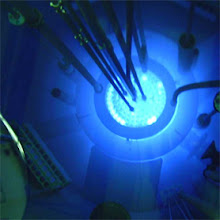Reaction to System Esthetics - Jack Burnham.
Burnham's article makes several observations about the evolution of art in the 20th century. I found some of the parallels between the advances of modern science and art to be particularly interesting. One of the first things he mentions is the idea that art is no longer merely restrained to boundaries. Sculpture, painting and other forms of classical fine art are typically defined by boundaries, while newer, un-objects, take into account the fact that works are often part of their surrounding environment, whether that environment is physical, social or conceptual. This concept parallels the scientific realization in quantum physics that the act of measuring often changes the system being observed. The observer becomes part of the system, the tools that are used become part of the equation, and the results are a combination of both observer and observed. The audience of a work of art will have social preconceptions, learned filters, and other influences that are part of the system, or work of art, rather than isolated from it.
Another concept Burnham discusses is that of the idea rather than that of the physicality. In classical terms, the most important part of an artwork is the physical object itself. The new paradigm he suggests is that of the idea, the process, or in other words, the information is just as important. Robert Morris' “68th American Show” entry was built using information – blueprints – rather than shipping the originals from New York. With the development and pervasiveness of computers in the next few decades, this seems to be a very profound observation for 1968: that information plays such an important part of daily life. Conscious or not, he is alluding to the developing scientific theories that are blurring the lines between reality and imagination – that information is the basis for reality. Artwork strives to organize this information in an aesthetically pleasing way. For the impressionists, this was the organization of the information of light. For modern artists the challenge comes to realize that information isn't only what we perceive with our five senses.
Burnham's article makes several observations about the evolution of art in the 20th century. I found some of the parallels between the advances of modern science and art to be particularly interesting. One of the first things he mentions is the idea that art is no longer merely restrained to boundaries. Sculpture, painting and other forms of classical fine art are typically defined by boundaries, while newer, un-objects, take into account the fact that works are often part of their surrounding environment, whether that environment is physical, social or conceptual. This concept parallels the scientific realization in quantum physics that the act of measuring often changes the system being observed. The observer becomes part of the system, the tools that are used become part of the equation, and the results are a combination of both observer and observed. The audience of a work of art will have social preconceptions, learned filters, and other influences that are part of the system, or work of art, rather than isolated from it.
Another concept Burnham discusses is that of the idea rather than that of the physicality. In classical terms, the most important part of an artwork is the physical object itself. The new paradigm he suggests is that of the idea, the process, or in other words, the information is just as important. Robert Morris' “68th American Show” entry was built using information – blueprints – rather than shipping the originals from New York. With the development and pervasiveness of computers in the next few decades, this seems to be a very profound observation for 1968: that information plays such an important part of daily life. Conscious or not, he is alluding to the developing scientific theories that are blurring the lines between reality and imagination – that information is the basis for reality. Artwork strives to organize this information in an aesthetically pleasing way. For the impressionists, this was the organization of the information of light. For modern artists the challenge comes to realize that information isn't only what we perceive with our five senses.

0 Comments:
Post a Comment
<< Home